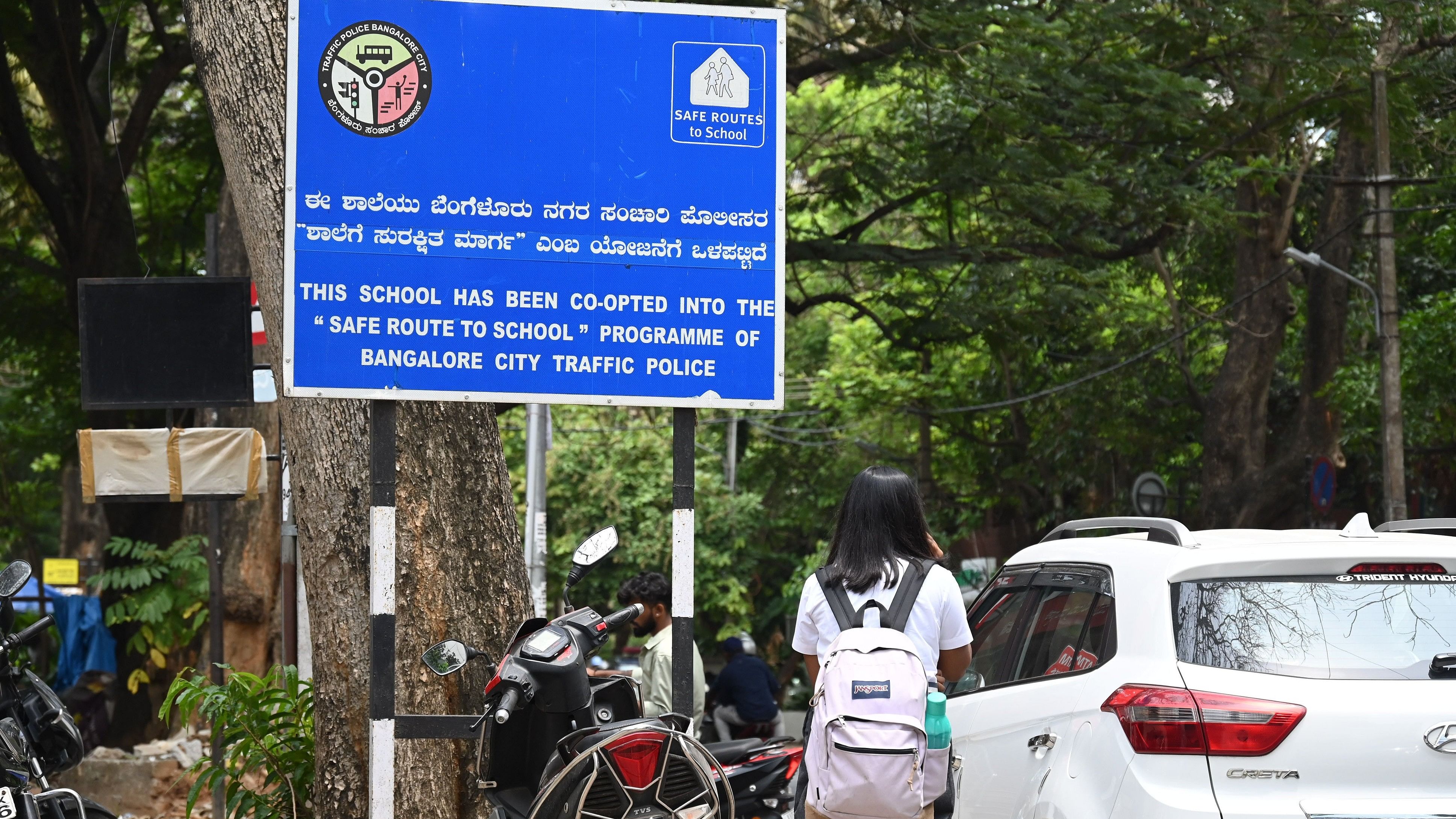
A board of the SRTS project installed a few years ago.
Credit: DH PHoto/Pushkar V
Bengaluru: Ahead of the start of the new academic year, the traffic police have drawn up a fresh proposal to implement the Safe Routes to School (SRTS) project for the safety of school students.
The umbrella project involves the collaboration of multiple stakeholders, including the Bengaluru Traffic Police (BTP), the Bruhat Bengaluru Mahanagara Palike (BBMP), the Bengaluru Metropolitan Transport Corporation (BMTC), the Department of School Education and Literacy, and school management across the city.
Traffic calming measures
For their portion of the project, the traffic police are focusing on enhancing road safety and ensuring students reach and leave their schools safely. Their proposal, which awaits approval, aims to clearly establish identifiable school zones in the city, especially around institutions in the Central Business District (CBD).
“We identified certain school zones where there are multiple schools in the vicinity to enhance road safety,” said M N Anucheth, Joint Commissioner of Police (Traffic).
He added, “We will be doing this by installing traffic-calming measures such as signboards and rumble strips made of thermoplastic material to reduce the speed of vehicles. We are also working with vendors to use reflective paint for safe pedestrian crossings and pavement markings.”
Anucheth noted that this is an attempt to visually change how school zones are created and perceived, ensuring vehicle users know when they are approaching a school zone, so they can be more cognisant of school children and create a sense of responsibility among them.
Traffic police have identified at least one school zone in each division. These zones will cover areas such as Ashoknagar, Shivajinagar, Jayanagar, Hennur and Indiranagar.
For example, the area across Residency Road-Vittal Mallya Road-Richmond Road has at least 11 schools, while there are several educational institutions along Palace Road, all of which see significant traffic congestion during morning peak hours.
If the allocated budget permits, the traffic police are willing to include some more areas and demarcate school zones better.
Parking, speed limits
Additionally, the traffic police will deploy more officers, home guards and traffic wardens wherever possible, to ensure they can manage traffic flow and ease congestion, especially in the morning.
However, Anucheth noted that this would not immediately reduce roadside parking and the resultant congestion. “The only way that can happen is if there is a designated space for vehicles to park inside the campus. But most schools don’t have that kind of space,” he said.
Speed limits will ideally be restricted to 30 kmph outside the schools but, according to the type of the road, can be between 30 kmph to 50 kmph.
Anucheth is confident this project can be completed in three months after approval is granted. The approval is likely to come after the model code of conduct is lifted.
Across divisions, the traffic police also plan to work with Resident Welfare Associations (RWAs) and school managements to explore the possibility of some residents and school staff volunteering to help students are picked up and dropped off at school safely.
History of the SRTS
The project was first conceptualised in 2006 by M A Saleem, the current chief of the Karnataka Criminal Investigation Department (CID), in collaboration with the Department of School Education and Literacy.
The department had then issued circulars to private schools, instructing them to open before 8.30 am and also take the services of the BMTC to provide pick-up and drop services to students so that private vehicles don’t take up space on important roads.
“The project was first restricted to only 16 schools in the CBD,” said Saleem, adding that the BMTC had, at the time, provided 220 buses specifically to ferry schoolchildren attending these schools.
In 2012, the project was relaunched under Saleem, who was the then Additional Commissioner of Police (Traffic), and expanded to schools beyond the CBD, given the number of schools mushrooming across the city. Additional measures such as banning parking in a radius of 200 metres around the school was also in place, which was also challenged by the school managements at the court.
When Saleem was appointed as the Special Commissioner of Police (Traffic) in November 2022, talks about rebooting the SRTS sprung up and the project was relaunched in 2023.
Dedicated buses for students?
Currently, the BMTC has casual contracts with at least 25 educational institutions in the city to provide dedicated buses for their students.
D Shashi Kumar, general secretary, Associated Managements of Primary and Secondary Schools in Karnataka, noted that the association has held meetings with the traffic police and the BMTC to introduce dedicated electric AC buses for students.
“For populated routes, the BMTC can introduce high-frequency buses to pick up and drop students from common points, such as BBMP grounds. Parents can drop off their children at these locations every day and pick them up after school. This will ensure that public transport is encouraged and private vehicles piling up outside schools will reduce,” he said.
He added that no authority has responded to their request.